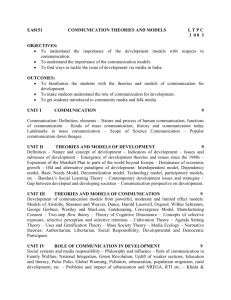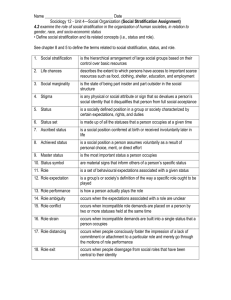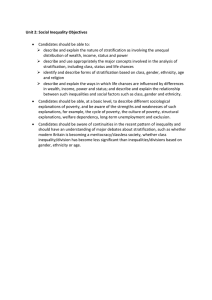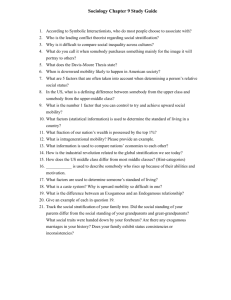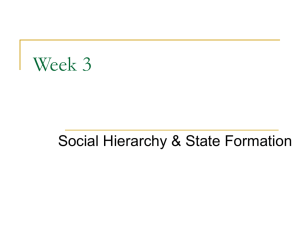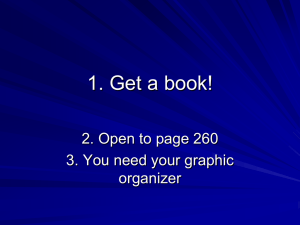Stratification
advertisement
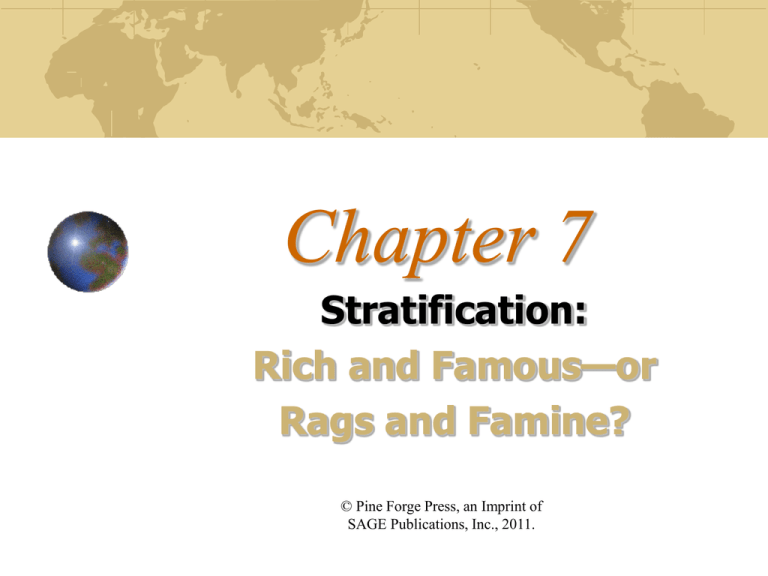
Chapter 7 Stratification: Rich and Famous—or Rags and Famine? © Pine Forge Press, an Imprint of SAGE Publications, Inc., 2011. The Importance of Stratification Social stratification: individuals and groups are layered or ranked in society according to how many valued resources they possess An ongoing process of sorting people into layers, legitimated by cultural beliefs that justify inequality © Pine Forge Press, an Imprint of SAGE Publications, Inc., 2011. The Importance of Stratification The concept of stratification assumes that: People are divided into ranked categories Desired resources are unequally distributed Each society determines how individuals are ranked, depending on: History Geographic location Level of development Political philosophy Decisions of those in power © Pine Forge Press, an Imprint of SAGE Publications, Inc., 2011. Micro-Level Stratification Prestige and Influence Property, power, and prestige are accorded to individuals with: Cultural capital: knowledge and access to important information Social capital: networks with others who have influence Individual qualities also influence cultural and social capital © Pine Forge Press, an Imprint of SAGE Publications, Inc., 2011. Meso-Level Stratification Access to Resources Individual status is shaped by access to resources and reinforced by the family through socialization Our treatment by educational, religious, political, and other institutions often depends on our status, and also reinforces it Our experiences of life are shaped by our status © Pine Forge Press, an Imprint of SAGE Publications, Inc., 2011. Macro-Level Stratification Macro-level influences on stratification: Economic systems and resources within a particular country Position of that country within world systems of economic stratification © Pine Forge Press, an Imprint of SAGE Publications, Inc., 2011. Theories of Stratification Micro-Level Theory Symbolic Interaction Individuals take up social positions through socialization, in which they learn the appropriate cultural capital Cultural capital influences children’s school and home environments Social positions are represented by symbols Conspicuous consumption: displaying goods in a way that will be noticed and will earn the owner respect © Pine Forge Press, an Imprint of SAGE Publications, Inc., 2011. Theories of Stratification Meso- and Macro-Level Theories Structural-Functional Theory Stratification within societies is inevitable The stratification system provides each individual with a position in the social world The stratification system motivates individuals to carry out their roles As a result, each individual contributes in some way to the maintenance of society © Pine Forge Press, an Imprint of SAGE Publications, Inc., 2011. Theories of Stratification Structural-Functional Theory, cont. The Davis and Moore Thesis Some positions are more highly valued because people feel they are very important Rewards for these positions are high because society must motivate talented individuals to undertake the necessary but difficult preparation for them Differential rewards for positions result in unequal distribution of resources; stratification is inevitable © Pine Forge Press, an Imprint of SAGE Publications, Inc., 2011. Theories of Stratification Meso- and Macro-Level Theories Conflict Theory Stratification is the outcome of struggles for dominance and scarce resources Individuals and groups act in their own selfinterest, taking advantage of others Conflict—between those trying to hold onto existing advantages and those trying to gain new advantages—is inevitable © Pine Forge Press, an Imprint of SAGE Publications, Inc., 2011. Theories of Stratification Conflict Theory, cont. Karl Marx, an originator of conflict theory Lived during a time of economic change which prompted him to question stratification Described distribution of wealth in capitalist societies as based on what people can take, not what they need, want, or earn © Pine Forge Press, an Imprint of SAGE Publications, Inc., 2011. Theories of Stratification Marx’s Conflict Theory, cont. Marx described two economic classes The bourgeoisie, capitalists, or “haves” The proletariat, working class, or “have nots” Conflict arises from struggle between classes: Capitalists control the means of production, i.e. money, materials, factories, which they use to create profits for themselves Since members of the working class lack their own means of production, they must work for capitalists in order to earn a living Therefore, capitalists can exploit workers in order to maintain and enlarge their profits © Pine Forge Press, an Imprint of SAGE Publications, Inc., 2011. Theories of Stratification Marx’s Conflict Theory, cont. Capitalists remain in control because: They control the norms and values of society They use their power to make inequality seem “fair” and justified This system will last until: The working class develops class consciousness, or shared awareness of the causes of their low status • They may be aided in this by intellectuals Based on class consciousness, the working class will overthrow the bourgeoisie and create a classless society in which wealth is shared © Pine Forge Press, an Imprint of SAGE Publications, Inc., 2011. Theories of Stratification Max Weber’s Conflict Theory Max Weber, also a conflict theorist, critiqued Marx’s sole focus on economic factors. His stratification theory included power and prestige, as well as property. Recent conflict theorists argue that there are 5 social classes: • Capitalists • Managers • Petty bourgeoisie • Workers • Underclass © Pine Forge Press, an Imprint of SAGE Publications, Inc., 2011. Theories of Stratification Meso- and Macro Level Theories Evolutionary Theory of Stratification To survive people must cooperate, but conflicts occur when important decisions advantage one group over another Valued items are always in demand but short supply; struggle over these scarce items is likely Custom shapes the distribution of scarce resources, but after basic societal needs are met, power determines distribution of surplus © Pine Forge Press, an Imprint of SAGE Publications, Inc., 2011. Theories of Stratification Evolutionary Theory of Stratification, cont. Synthesis of functionalist and conflict theories: Structural functionalism • Talented individuals need to be motivated Conflict theory • Individuals will attempt to control as much wealth, power, and prestige as possible, resulting in potential conflict • Exploitation contributes to creating inequality Level of inequality depends on technology Some inequality is useful, too much can be harmful © Pine Forge Press, an Imprint of SAGE Publications, Inc., 2011. Individual Social Status The micro-level: Individual Life Chances Life chances: one’s opportunities, which depend on achieved and ascribed statuses Important factors affecting life chances: Education Health, social conditions, and life expectancy © Pine Forge Press, an Imprint of SAGE Publications, Inc., 2011. Individual Social Status Individual Lifestyle Lifestyle: one’s attitudes, values, beliefs, and behavior patterns, which depend on socialization into one’s culture and status Factors affecting lifestyle: Attitudes toward achievement Family life and child rearing patterns Religious membership Political behavior Status inconsistency © Pine Forge Press, an Imprint of SAGE Publications, Inc., 2011. Social Mobility The Micro-Meso Connection: Social Mobility Social mobility: the extent to which people move up and down in the class system Four issues dominate analysis of mobility: Types of social mobility Methods of measuring social mobility Factors that affect social mobility Whether there is a “land of opportunity” © Pine Forge Press, an Imprint of SAGE Publications, Inc., 2011. Social Mobility Types of Social Mobility Intergenerational mobility: change in status compared to parents’ status, usually resulting from education and occupational attainment Intragenerational mobility: change in status within an individual’s life, whether up or down Vertical mobility: movement up or down the stratification hierarchy, sometimes including a change in social class © Pine Forge Press, an Imprint of SAGE Publications, Inc., 2011. Social Mobility Measuring Social Mobility Traditional method: compare the occupations of fathers and sons or daughters There is a high level of occupational inheritance The higher the father’s occupation, the greater the son’s chances of occupational success There is considerable intergenerational movement up and down the ladder Sons are more likely to move up than down; daughters are even more likely to move up Men’s and women’s occupational attainment is powerfully influenced by class origins © Pine Forge Press, an Imprint of SAGE Publications, Inc., 2011. Social Mobility Factors Affecting Individual Mobility Micro-level factors Family background, socialization, and education Macro-level factors National occupational structure & economic vitality National population trends (Dis)advantages linked to gender and ethnicity Global markets and events Many of these factors are interrelated © Pine Forge Press, an Imprint of SAGE Publications, Inc., 2011. Social Mobility Is there a “land of opportunity”? Comparing mobility across cultures It is difficult to identify opportunity-rich countries due to the complex factors that influence mobility Opportunities for upward mobility are changing due to globalization Manufacturing jobs are now in developing countries, leaving less-educated US workers with fewer opportunities The US has high-tech jobs, providing opportunity for those from small, educated families that value individual achievement © Pine Forge Press, an Imprint of SAGE Publications, Inc., 2011. Stratification Macro-level analysis: Major Stratification Systems Ascribed stratification systems: individuals’ positions in society are determined by characteristics they are born with Achieved stratification systems: individuals earn their positions through ability and effort © Pine Forge Press, an Imprint of SAGE Publications, Inc., 2011. Stratification Ascribed Status Systems Caste systems: the caste one is born into determines one’s occupation, potential marriage partners, residence, group memberships, and prestige level An individual’s caste is recognized through clothing, speech, family name, skin color, other characteristics Individuals learn their caste through socialization The most rigid ascribed status system; maintained by norms, ideologies, and social control mechanisms embedded in religious, political, and economic institutions © Pine Forge Press, an Imprint of SAGE Publications, Inc., 2011. Stratification Ascribed Status Systems Estate systems: one is born into the nobility, the political-military elites, or into the peasantry, whose labor supports the elites Peasants receive protection and enough food to survive from the nobility Peasants are tied to a noble’s land and are rarely able to become independent land-owners Ranks and rights are clearly spelled out The system is bolstered by arranged marriages © Pine Forge Press, an Imprint of SAGE Publications, Inc., 2011. Stratification Achieved Status Systems Social class system: social class is defined by property, power, and prestige; it is officially achieved, but actually inherited in part Property: income and assets Power: ability to control or influence others (Power Elite vs. Pluralism models) Prestige: recognition, esteem, respect given those whose occupation and lifestyle are socially valued Class members share similar lifestyles, education, culture, and interaction patterns © Pine Forge Press, an Imprint of SAGE Publications, Inc., 2011. Social Classes in the United States Most people in the U.S. identify as “middle class,” but the middle class is shrinking The gap between the richest 5% and poorest 40% has increased since the 1970s Middle class wages and salaries have declined since the 1980s © Pine Forge Press, an Imprint of SAGE Publications, Inc., 2011. Poverty Poverty Determinants and Social Policy Absolute poverty: not having sufficient resources to meet basic survival needs Also no prestige, power, or accumulated wealth Relative poverty: having an income below the poverty line, and an inadequate standard of living relative to others in the same country Also poorer health, shorter life expectancy, greater infant mortality than others in the same country © Pine Forge Press, an Imprint of SAGE Publications, Inc., 2011. Poverty Poverty Determinants and Social Policy Feminization of poverty: trend in which single females, often young and with children, make up a growing proportion of those in poverty Many poor women grew up in female-headed families or suffered economically following divorce Prevalent in and around major cities Explained by • Blaming the victim • Conflict perspective: poor women comprise a reserve group of cheap, easily exploited laborers © Pine Forge Press, an Imprint of SAGE Publications, Inc., 2011. Poverty Poverty Determinants and Social Policy Social costs of poverty The poor have lower physical and mental health, are more alienated, have higher rates of addiction Financial cost of addressing the needs of and regulating the poor Loss of talent and abilities that the poor could contribute Contradiction to cultural values of equality and upward mobility © Pine Forge Press, an Imprint of SAGE Publications, Inc., 2011. Poverty Eliminating Poverty: Policy Considerations Most welfare programs aim to eliminate poverty by changing the factors that perpetuate it Requires jobs, money, altering our social institutions Aid Programs: Women, Infants, & Children (WIC) program: nutrition Head Start: early childhood education Medicaid Medicare Food stamps Workfare (TANF) © Pine Forge Press, an Imprint of SAGE Publications, Inc., 2011. Poverty Eliminating Poverty: Policy Considerations Workfare Temporary Assistance for Needy Families (TANF) Replaced Aid to Families with Dependent Children (AFDC), which was criticized as creating dependence Requires individuals receiving assistance to work 2030 hours/week or attend training/education Issues and questions • Are there jobs available at a “living wage”? • Voters want tax cuts, which reduce our ability to help • Prisons take public funds that could be used to fight poverty © Pine Forge Press, an Imprint of SAGE Publications, Inc., 2011. Macro-Level Stratification The National and Global Digital Divide Digital divide: the gap between those with and without access to information technology. Results from differences in socioeconomic status, minority group status, and urban versus rural residence Individuals with insufficient computer and internet access or skills face barriers to many professions and opportunities Public and private organizations are developing low-cost technologies that may help level the digital playing field © Pine Forge Press, an Imprint of SAGE Publications, Inc., 2011.
